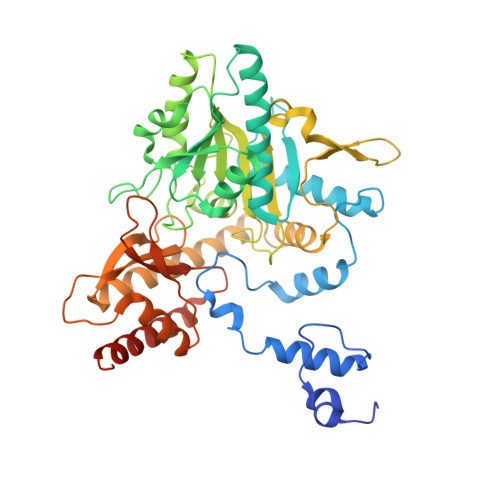Lactobacillus brevis CGMCC 1306 glutamate decarboxylase: Crystal structure and functional analysis.
Huang, J., Fang, H., Gai, Z.C., Mei, J.Q., Li, J.N., Hu, S., Lv, C.J., Zhao, W.R., Mei, L.H.(2018) Biochem Biophys Res Commun 503: 1703-1709
- PubMed: 30049439
- DOI: https://doi.org/10.1016/j.bbrc.2018.07.102
- Primary Citation of Related Structures:
5GP4 - PubMed Abstract:
Glutamate decarboxylase (GAD), which is a unique pyridoxal 5-phosphate (PLP)-dependent enzyme, can catalyze α-decarboxylation of l-glutamate (L-Glu) to γ-aminobutyrate (GABA). The crystal structure of GAD in complex with PLP from Lactobacillus brevis CGMCC 1306 was successfully solved by molecular-replacement, and refined at 2.2 Å resolution to an R work factor of 18.76% (R free = 23.08%). The coenzyme pyridoxal 5-phosphate (PLP) forms a Schiff base with the active-site residue Lys279 by continuous electron density map, which is critical for catalysis by PLP-dependent decarboxylase. Gel filtration showed that the active (pH 4.8) and inactive (pH 7.0) forms of GAD are all dimer. The residues (Ser126, Ser127, Cys168, Ile211, Ser276, His278 and Ser321) play important roles in anchoring PLP cofactor inside the active site and supporting its catalytic reactivity. The mutant T215A around the putative substrate pocket displayed an 1.6-fold improvement in catalytic efficiency (k cat /K m ) compared to the wild-type enzyme (1.227 mM -1 S -1 versus 0.777 mM -1 S -1 ), which was the highest activity among all variants tested. The flexible loop (Tyr308-Glu312), which is positioned near the substrate-binding site, is involved in the catalytic reaction, and the conserved residue Tyr308 plays a vital role in decarboxylation of L-Glu.
- School of Biological and Chemical Engineering, Zhejiang University of Science and Technology, Hangzhou, 310023, PR China; Department of Biological and Pharmaceutical Engineering, Ningbo Institute of Technology, Zhejiang University, Ningbo, 315100, PR China.
Organizational Affiliation:

















